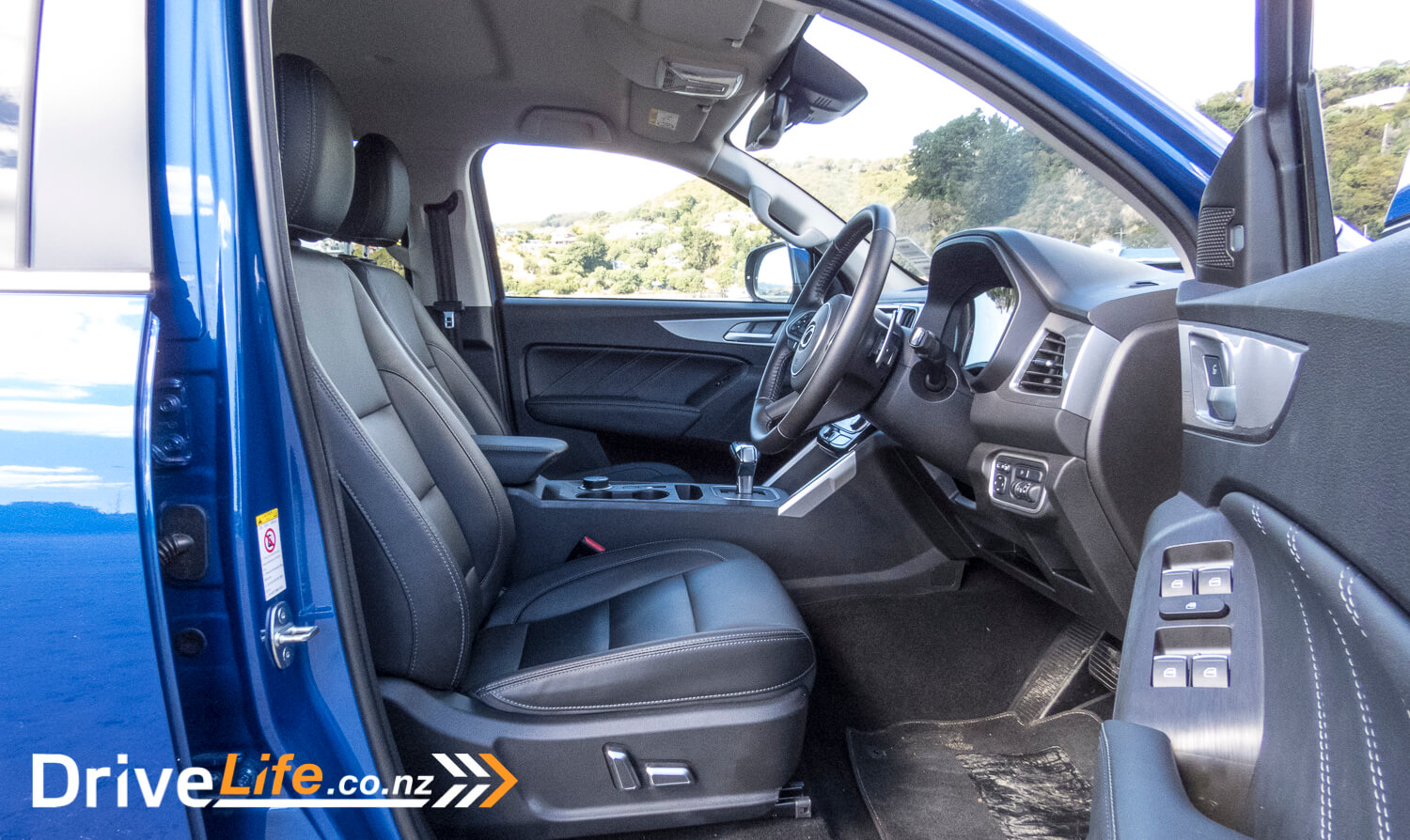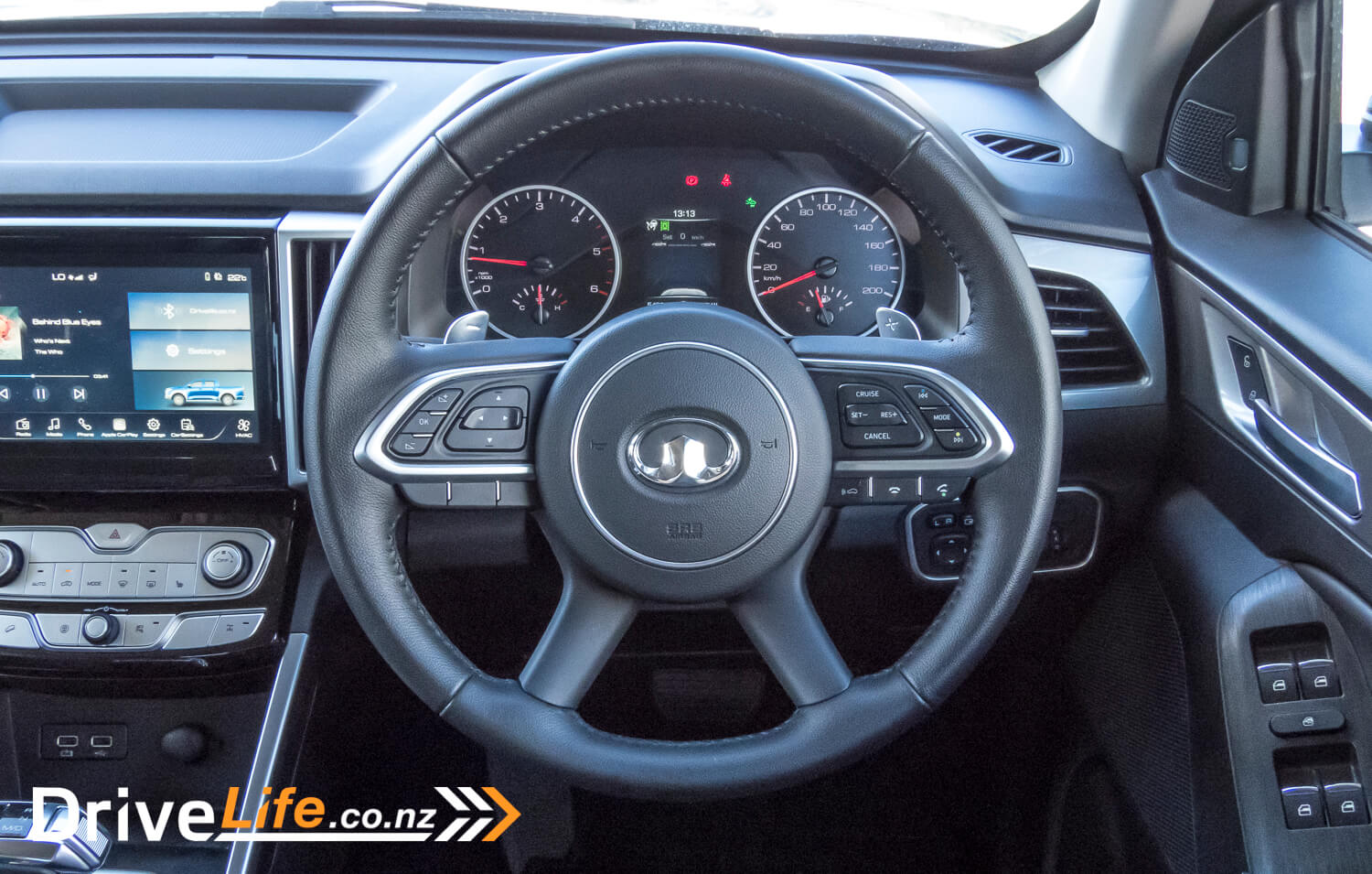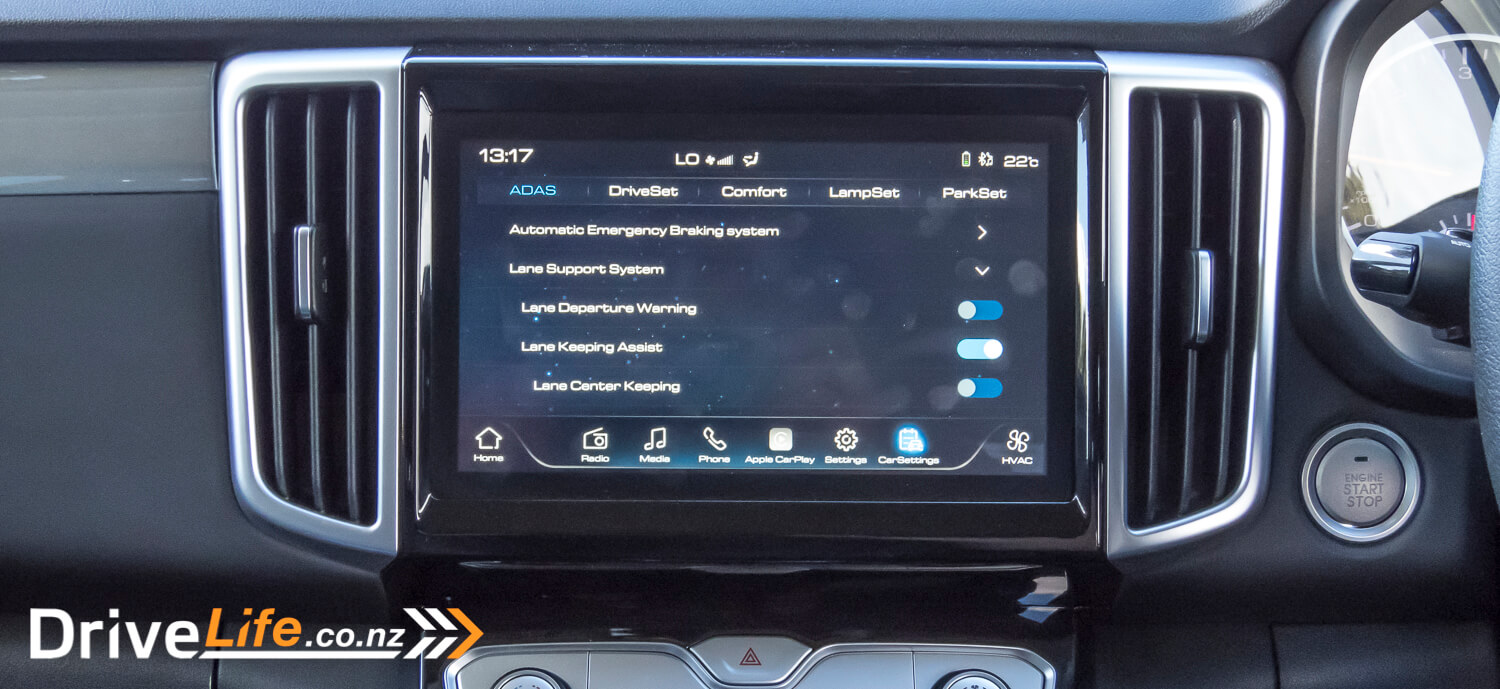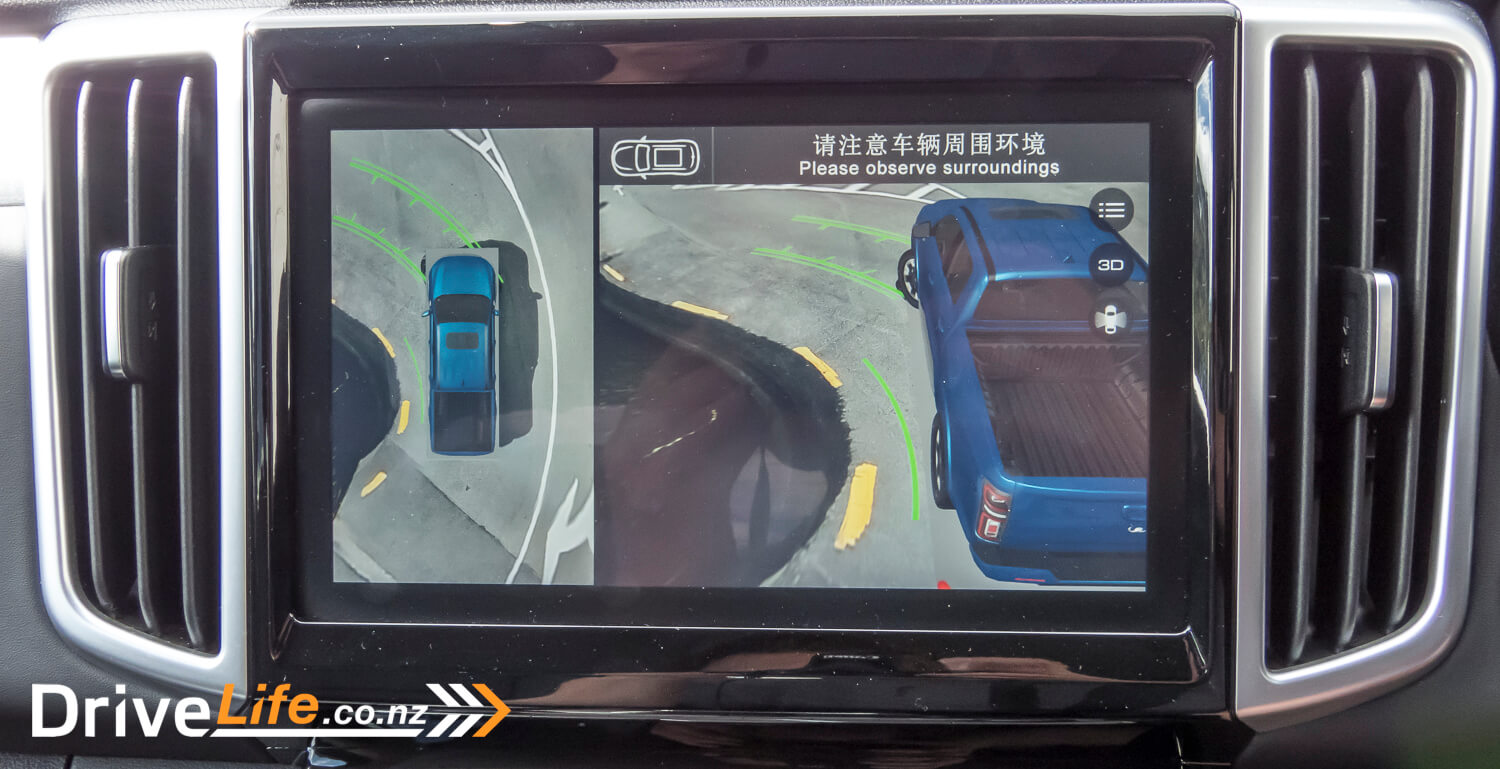You needn’t go to the end of the earth to know that utes are more popular than ever. Survey the road network, you’ll find utes in the supermarket carpark, doing the school run, and occasionally on the job site. You could be living under a rock, and yet you’d probably still know the name ‘Hilux’.
Yet, being popular comes with a cost, and said cost has bloated the price of utes over the past decade.
So, you want a top-spec Hilux? That’ll be $60,000. Hm, alright, how about a top-spec Ranger? $70,000! Whoa okay, a D-Max then? $70,000?! Huh?!
And those prices are before you’ve even realised that they’re technically not even the top of their range. Move to the very top of the range, you’ll find the increasingly popular super-ute class, with contenders such as the Ford Ranger Raptor, the Toyota Hilux Mako, and Nissan’s Navara Warrior.
Oh, and if you want to join this club, a Ranger Raptor starts at $84,999. Ouch.
So, somewhere during the course of the decade, utilitarian utes have fallen into Mercedes money. Little wonder car companies are eager to cash-in on this trend.
Yet, one cannot help but question the affordability aspect. How many Kiwis are making the financial stretch to pay for the latest and greatest toys in their new ute? Clearly, the answer is many, but is it sustainable?
One would naturally think there’s a gap in the market for an affordable ute with all the toys included? But entering the ute market is clearly not as easy as it seems.
We’ve seen plenty of credible attempts, but not many of them have stuck. Heck, SsangYong tried to make their Acyton and Rhino utes appeal more with a racing series, but such an exercise only got them so far. Even Mercedes themselves tried to crack the market with the X-class, which was subsequently discontinued in May 2020.
So how does Great Wall, a Chinese manufacturer with small brand presence in New Zealand, intend to crack into the market with the GWM Cannon ute? On paper their formula appears compelling; plenty of capability, offered with huge spec offered at a reasonable price.
The main question is will Kiwi buyers like it? Can it overcome the stigmas of Chinese-manufactured utes which came before it? GWM gave us the keys for a week to test it out.

What’s In The 2021 GWM Cannon Range?
The GWM Cannon Ute has three variants offered for the New Zealand line-up. All models are double-cab, two of the three are two-wheel drive variants and the final one is four-wheel-drive. These are priced below:
| Model | Transmission | Price |
| 2WD GWM Cannon | Manual | $29,990 |
| 2WD GWM Cannon L | Auto | $35,990 |
| 4WD GWM Cannon L | Auto | $39,990 |
Our test vehicle is the top-of-the-range, 4WD GWM Cannon ute.
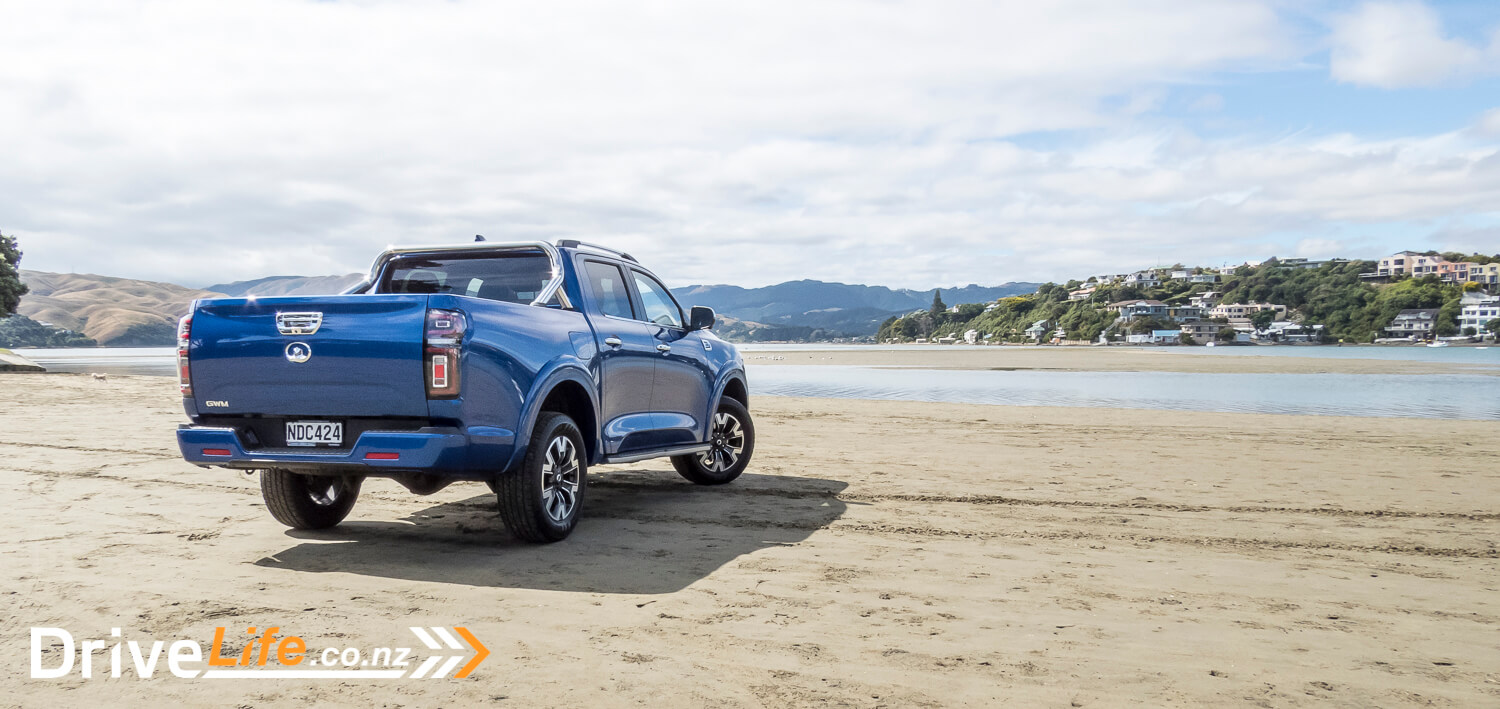
2WD GWM Cannon
At the start of the range is the base-spec GWM Cannon. You might be thinking that a ute at this price level would have fewer features than a jail cell. Yet, in the case of the Cannon, you’d be wrong.
The base spec Cannon comes well equipped, offering; 18’’ alloy wheels, a 9’’ infotainment with Apple Carplay and Android Auto, 4 speakers, synthetic leather seats, reverse camera, automatic LED headlights and DRLs, keyless entry and push button start, ISO-FIX in rear seats and rear parking sensors.
2WD GWM Cannon L
Graduate up to the Cannon L, you’ll gain some big-ticket items. These include; a different set of 18’’ alloys, 6-speaker audio, heated front seats, automatic climate control, leather steering wheel, 6-way power driver’s seat, adaptive cruise control, privacy glass, auto dimming rear view mirror, tailgate step, front parking sensors and a trick 3600 around-view camera.
4WD GWM Cannon L
The 4WD Cannon variant offers virtually all the same interior features of the 2WD Cannon L, instead your extra cash goes onto the drivetrain. The 4WD Cannon L gains an electronic handbrake, engine immobiliser, a centre differential with lock function, switchable driving modes and switchable power steering assistance modes.
All models of GWM Cannon are powered by a 2.0-litre 4-cylinder turbo-diesel producing 120kW/400Nm of torque. The engine is paired to an 8-speed ZF automatic gearbox, or a 6-speed manual in the base model. Towing capacity is up to 3,000kg braked, or 750kg unbraked, while the tray has a 1,050kg max payload. Cannon L models also gain 4-wheel disc brakes, whereas the base Cannon has rear drum brakes instead.
The entire GWM Cannon range is equipped with several standard safety features across all models, including; vehicle stability control, forward collision warning, autonomous emergency braking with pedestrian and cyclist detection, lane keep assist, rear cross traffic alert, tyre pressure monitoring and traffic sign recognition.
Despite this comprehensive list of safety technology, the GWM Cannon ute currently is untested by ANCAP and does not have a safety rating as of the time of writing.
There are five different colour options for your Cannon, which are Pure White, Pittsburgh Silver, Scarlet Red, Blue Saphire (no typos here) and Crystal Black.
For more information on the GWM Cannon Ute, check out the GWM Haval New Zealand website.
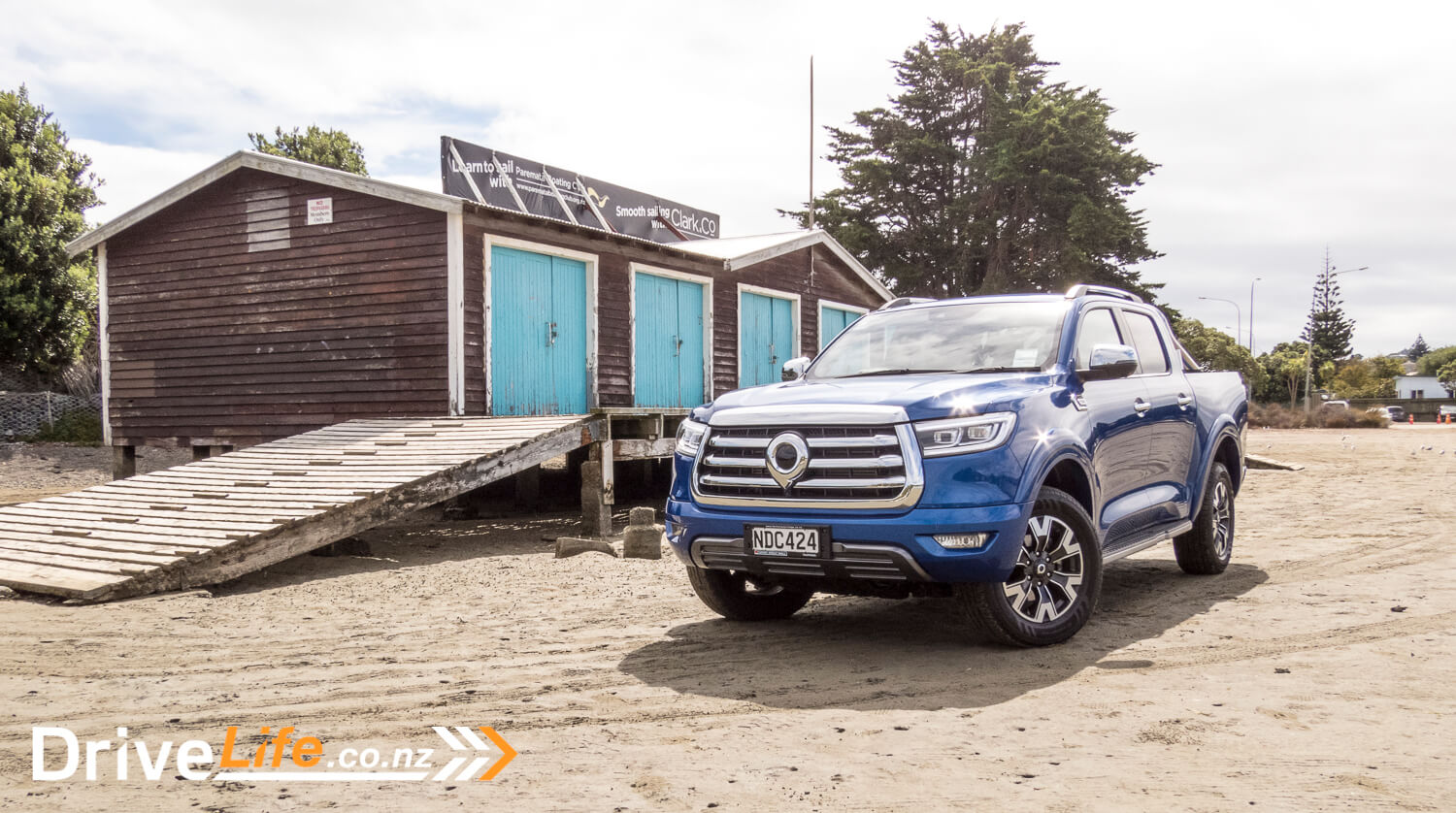
First Impressions Of The 2021 GWM Cannon L?
Damn, this ute is big.
Or is it?
There’s some misleading cues here, but the Cannon is a fraction larger than most of the competition.
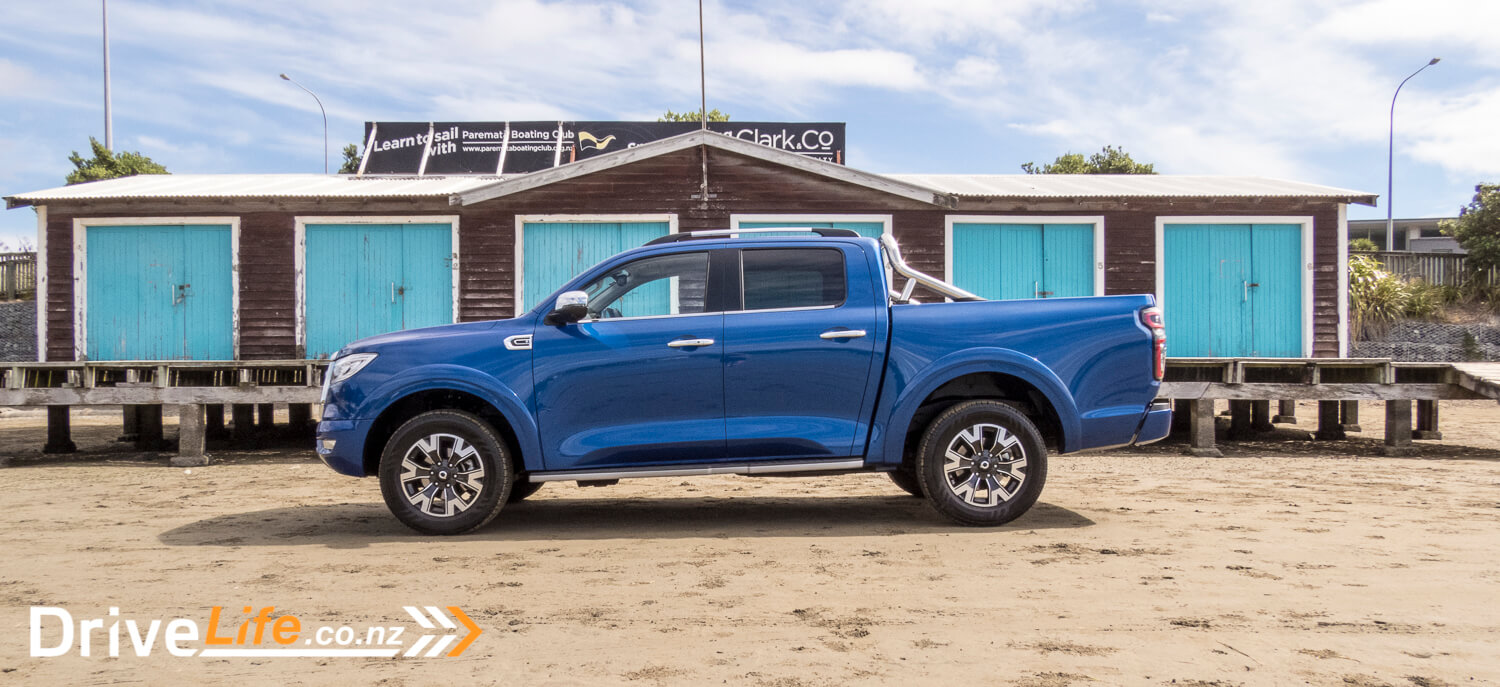
How does one know? A simple glance at the spec sheet will tell you that the Cannon is 67mm taller and 34mm wider than a Ranger XLT. The wheelbase is 10mm longer, but the overall body is 36mm shorter on the GWM.
But I prefer the practical test. Go and park next to a Ranger and the high beltline of the Cannon makes the Ranger actually seem much smaller.
These large dimensions are probably due to the chief designer’s background, previously employed by Ford and Chevrolet in America.
One could also get the impression they intended to make the ute even larger judging by the size of the front grille. It’s so large, one could imagine they started drawing the grille before being told “oh, not that big”, then proceeding to draw the ute around it.
Size jokes aside, the grille doesn’t actually look out of place. It works; much like the rest of the design. The features are all quite big, but not disproportionate. Importantly, the larger dimensions make the GWM look substantial, which subconsciously signals a tough and well-built product. I can imagine this was a design objective for the Chinese newcomer, to stave off any impressions of sub-par quality.
Overall, I’m pretty impressed with the Cannon. This blue is rather sharp too.
Nice work GWM.

What’s The Interior Like On A 2021 GWM Cannon L?
It’s tough to know what to expect when climbing into a ute these days. Some attempt to go up-market, whereas others remain true to their work-ute lineage.
So for the GWM Cannon, I wasn’t entirely sure what to expect given the price point. GWM’s marketing bumph claims this a European designed cabin, which I suspect, is to signal some level of quality. In reality, that just means it’s going to have Europeanisms about the cabin as opposed to it being high-end. One clear example of these Europeanisms in the GWM is that the indicator stalk is on the left-hand side, but that’s essentially about it.
For the most part, I was pleasantly surprised with the cabin quality. Stepping inside, you’ll encounter a well-equipped and logically laid out cabin. The interior wouldn’t look too out of place if you were to cut and paste it into a crossover, which actually a decent compliment for a ute.
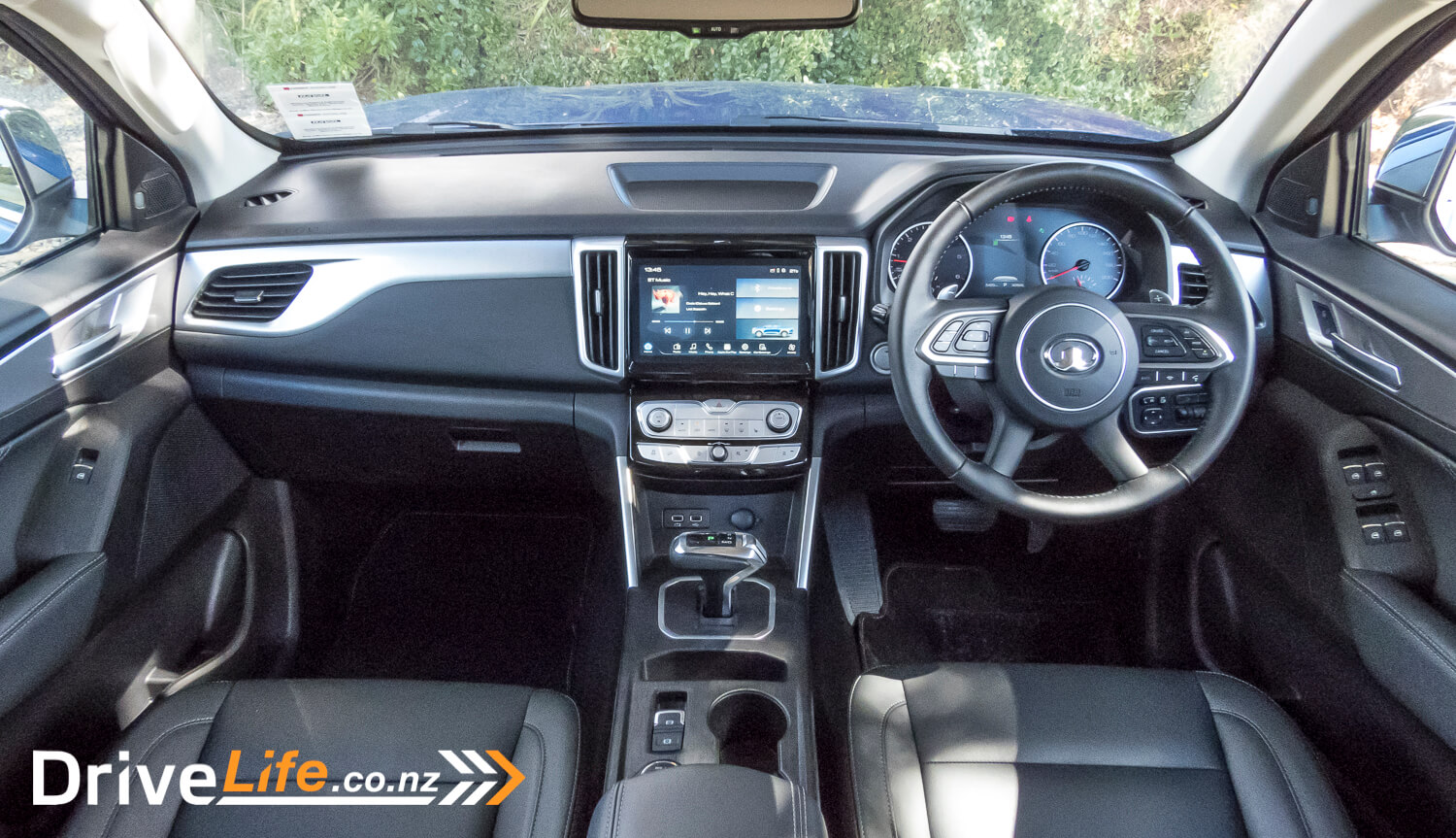
However, there are a few giveaways that this is a cheaper product. Many of the textures are plasticky, but they’re neither hard nor scratchy. I wouldn’t call them bashable either, which means this ute is more geared towards lifestyle types over your tradie types. But let’s be honest, many higher end utes are used more for recreation as opposed to creation these days.
As you’ve probably seen from the spec sheet, the level of standard equipment is where the GWM really scores points.
Up front is a 9’’ infotainment screen, which offers Apple Carplay and Android Auto. GWM’s own interface is user-friendly and the screen has good resolution. Interactions are only slightly laggy, which makes it better than many other utes on the market. My main criticism is that the unit has many duplicate functions, meaning many controls both soft and hard, will take you into the same menus.
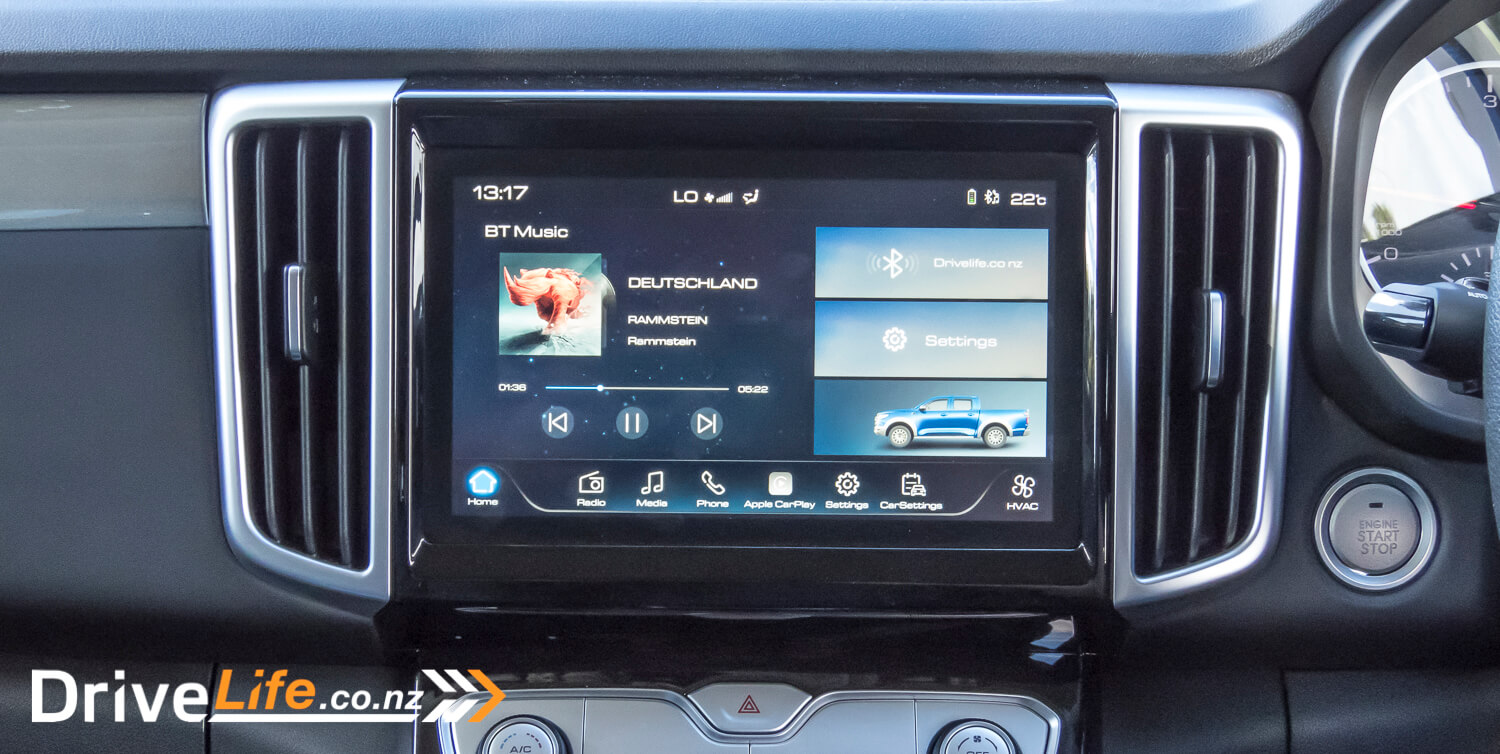
The real feature to write home about is the 360-degree camera. There’s a series of little cameras around the vehicle which can produce an augmented reality of the surroundings and display it directly onto the screen. I’ve seen this feature before in other vehicles, but those vehicles often have tens of thousands added to the price. I’ve personally never seen a camera set-up this comprehensive in any ute, yet alone for any vehicle at $40,000. Given how big the GWM is, you’ll actually derive some good usage from this system and the multiple projections it can display.
The image quality produced by the cameras is good too, displayed with high resolution and good refresh rates.
The infotainment is linked up to a 6-speaker audio system which also scores a reasonable mark. It’s not of audiophile standards, but there’s nothing inherently wrong with the soundstage nor the quality.
In the front seats, the driver and passenger can easily get comfortable. The driving position is decent, and there’s enough adjustability between the steering wheel and the 6-way electric seat. It’s worthwhile noting that only high spec models have reach adjustment for the steering wheel, but all models do at least get tilt adjustment.
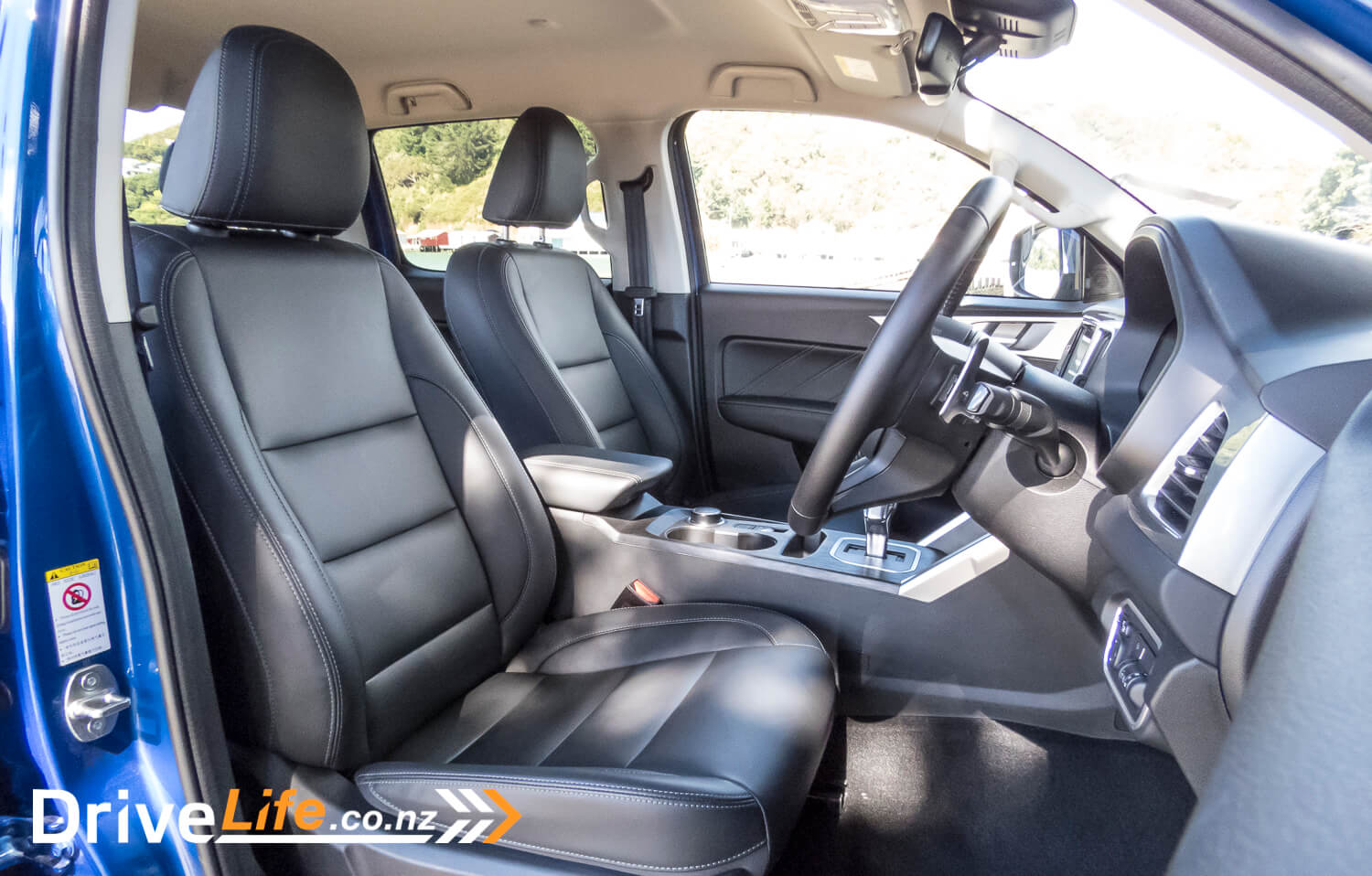
The seats themselves are comfortable, offering decent back and lumbar support. They are quite scalloped out, meaning your thighs run at an upper angle. The seat base isn’t the longest, meaning taller folk might find a lack of under thigh support. Also, the fake leather isn’t fooling anyone. Overall, I had few complaints on our longer open-road journeys.
The rear space in the GWM is excellent, offering ample head and legroom for passengers. You could easily ferry three adults in the back in comfort. There’s also a 220-volt power outlet and a single USB port. Outside, there’s a wide running board, meaning it’s slightly easier than most to egress.
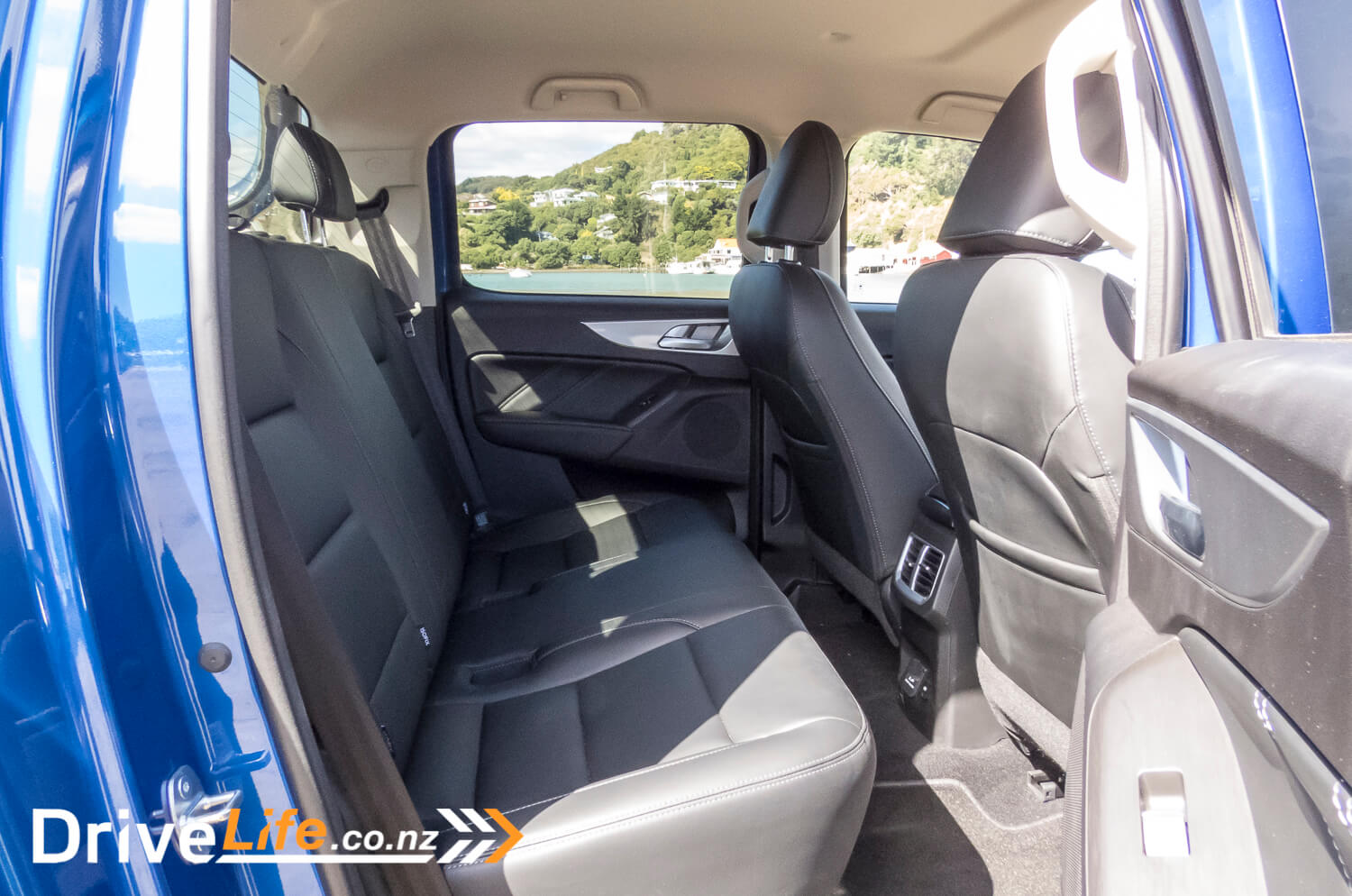
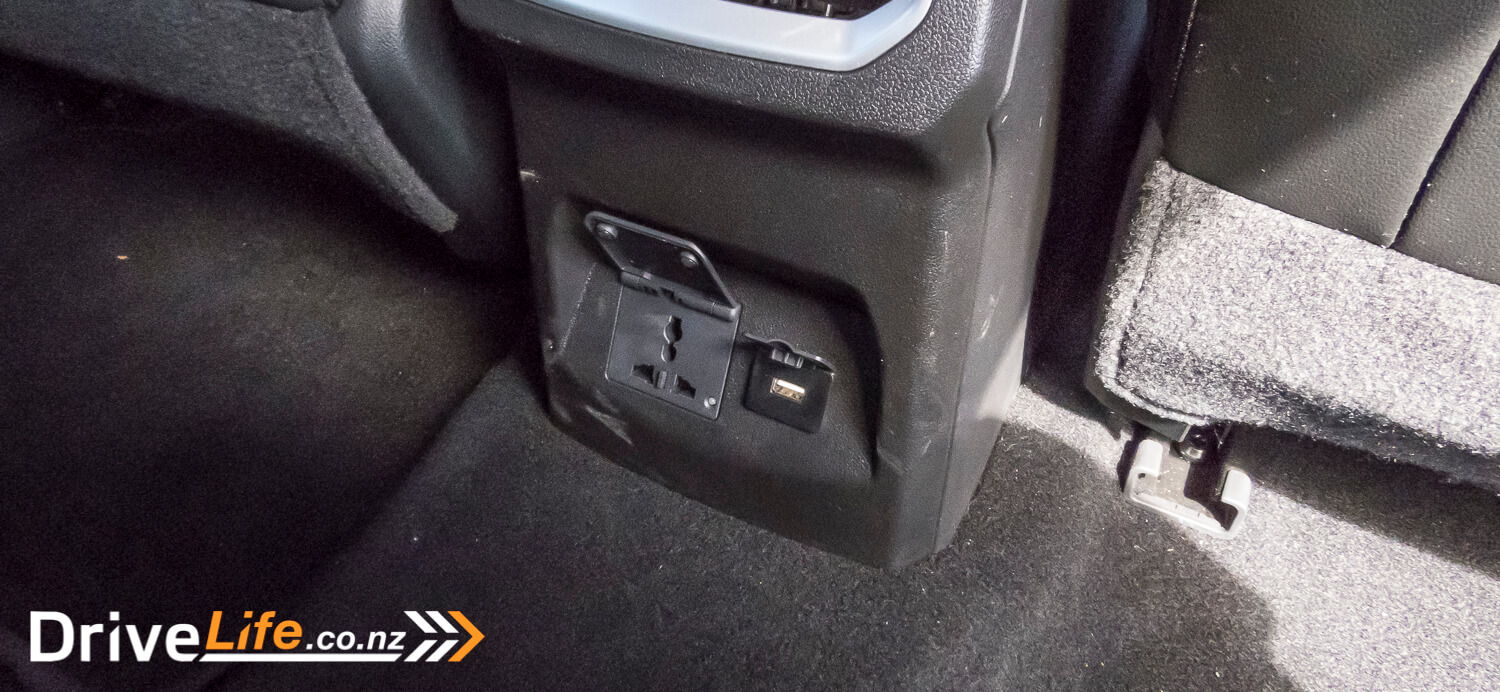
On the subject of rear space, the tray is essentially a perfect square. Tray width is 1520mm and length is 1520mm as well. The width between the arches is 1120mm, meaning you might just be able to sneak a pallet in there. The tray is spray lined as opposed to rubber lined.
Much like the 360-degree camera, another first is the pop-out tailgate step from the rear tailgate. Again, another feature which the GWM has thought about over the competition.
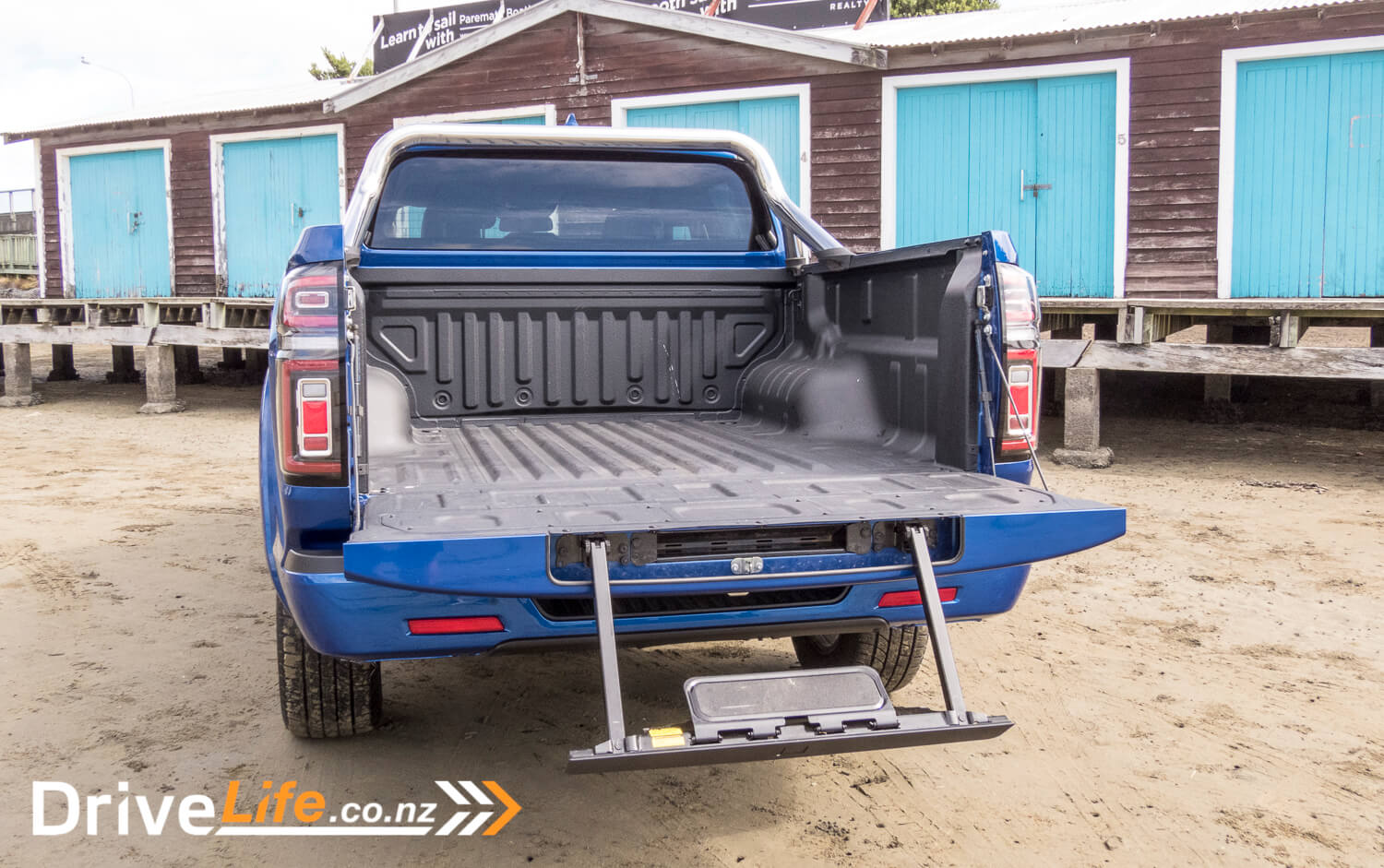
GWM has also thought of another few liveability features, which is not only a bonus for the price, but also shows they’re paying attention to detail. For example, the rear tailgate has gas struts on it, meaning it gently lowers as opposed to dropping with a thunk. Gas struts are also used up front under the bonnet.
However, there are a couple of features which hadn’t been given so much thought. The first of these is the sunglasses holder, which is situated where an overhead grab handle usually is above the driver. At least twice, I went to grab it and nearly had a situation where I’d have yanked it clean off. It also highlighted that there’s no grab handle to help the driver get in.
The second annoyance is with the instrument cluster, but we’ll cover this in The Drive section of our review.
What Does The 2021 GWM Cannon L Drive Like?
If you’re at all cynical, I can guess what you might be thinking at this stage. Sure, the ute is impressively equipped, but surely the driving experience won’t be as good as the rest?
Before I cover this, you might actually have a few points in your favour. On paper, the engine specs aren’t as strong as the mainstream competition. GWM’s in-house built, 2-litre 4-cylinder turbo-diesel produces 120kW of power and 400Nm of torque. That’s a 30kW and 100Nm deficit on a Hilux, or 20kW/50Nm down on a D-Max or BT-50.
The tow rating isn’t as high as the major competitors either, and I’m guessing you might have reliability concerns too, which is probably justified based on GWM’s of old.
But hold the phone a minute.
Firstly, and I know this might sound blasphemous to us car people, but power figures aren’t the entire story. I’m not saying power doesn’t matter, but sometimes the peak figures tell you only half the story about how the car actually delivers its power.
Secondly, GWM, while newcomers in Australasia, are the biggest SUV and ute producers in the world’s largest car market – China.
Furthermore, the 8-speed gearbox is made by ZF. Yep, the gearbox was designed by a German company. For the uninitiated, ZF has produced gearboxes for many, including brands like BMW, Mercedes and Ferrari. Even the transfer case is made by Borg-Warner, which goes to show, there has been some decent investment into the drivetrain.
The final bit, regarding the tow rating, the guys at GWM have signalled that this is merely a matter of bureaucracy as opposed to capability. Of course, that’s only their word against what’s written on paper.
So altogether, you’ve got an engine from a company that’s sold millions of vehicles worldwide, and a gearbox designed by a firm who regularly gets requests for some of the most high-end vehicles on the road, and a few other reputable mechanical bits to boot!. Numbers aside, this actually seems like the start of a solid recipe.
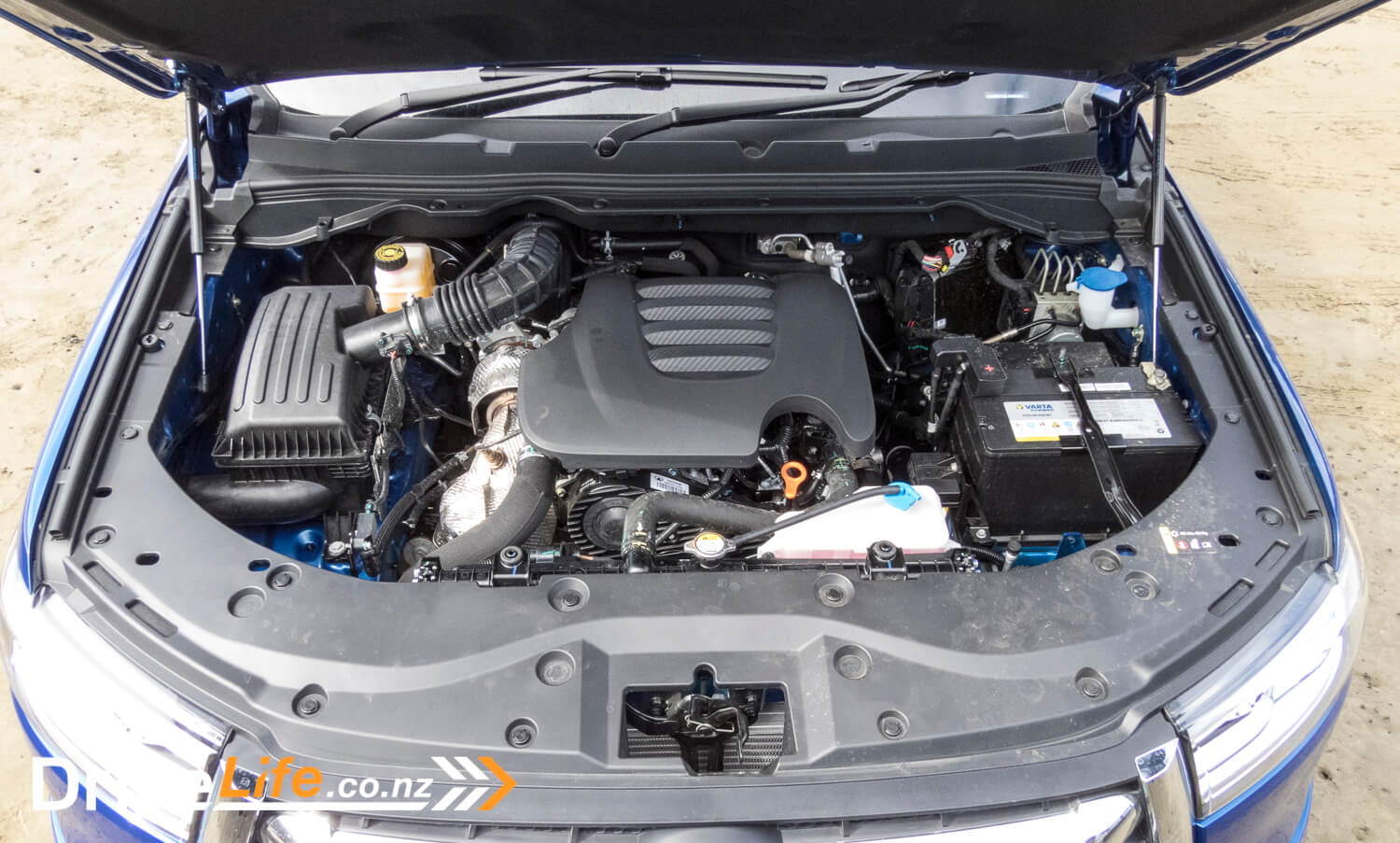
So, how does it actually perform? Well, mostly good!
Although underpowered on paper, the engine has a healthy power and torque curve, and delivers satisfactory performance in the mid-range. There’s adequate power for suburban driving, and it’s also up there in terms of refinement with the competition.
Where you will notice the power deficit is right at the very top and bottom of the rev range. The engine does feel exerted heading towards the higher rev range. From a standstill, you’ll also notice a lack of thunder from the ute, as the engine does have a bit of turbo lag. However, once you’ve picked up, it moves fairly along quickly and quite undramatically.
I should expand a bit more on “mostly”. There is a problem, but not from an area where you’d expect. The issue is actually with the ZF gearbox. Just to make it clear, the gearbox is by many counts, an excellent gearbox. The transmission also does a great job when the car is already moving, shifting seamlessly between gears.
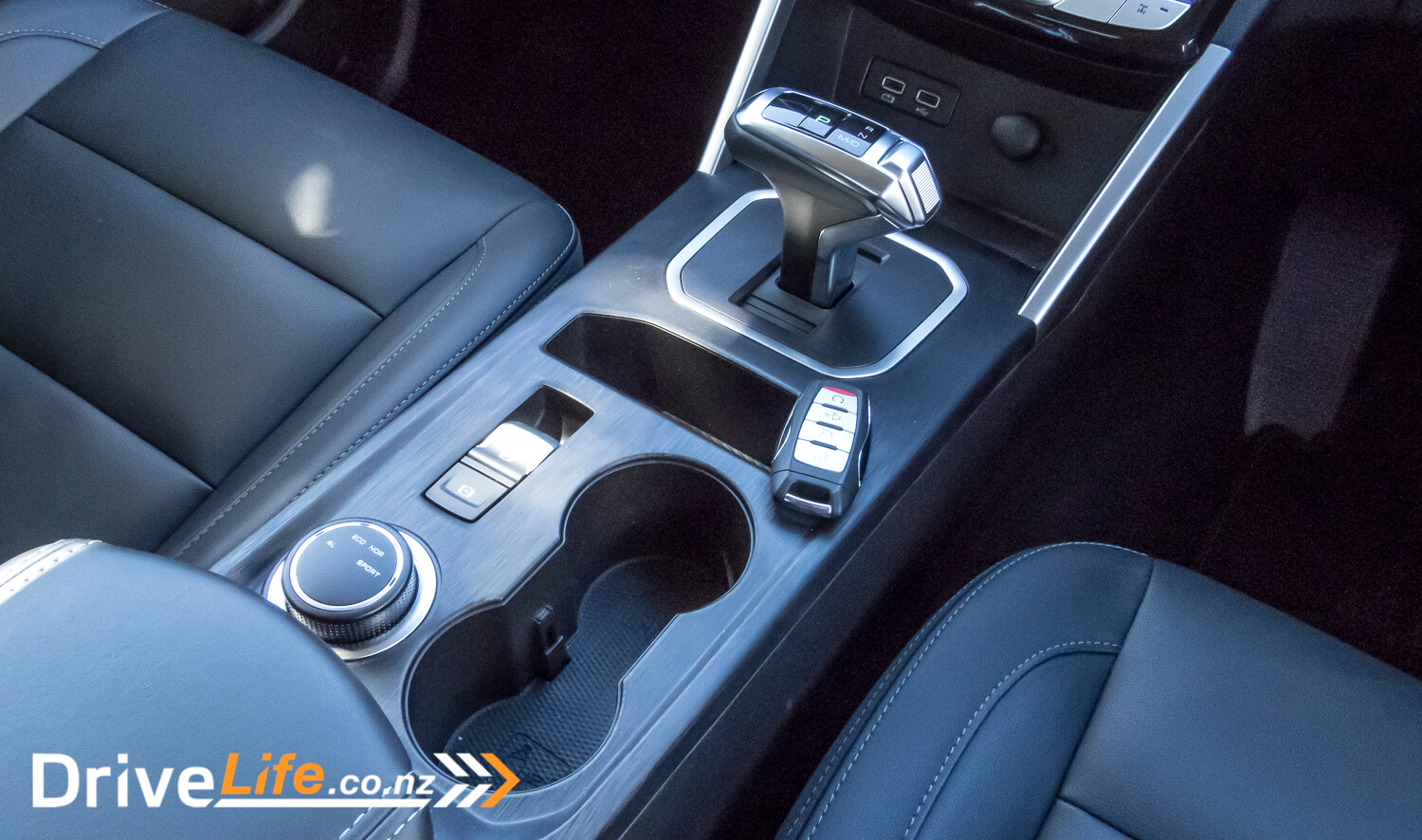
However, I think the Cannon could benefit from a bit more real-world calibration between the engine and transmission. What do I mean exactly? For example, if you give the accelerator a stab off the line, the engine will experience its turbo lag and the ute will move off rather slowly. Once the boost creeps on, it is the tendency of the gearbox to suddenly throw you into 3rd gear, meaning you’d often get quite a sudden and seemingly uncontrolled jolt of performance.
Another issue is that the gearbox was a tad overactive. When sitting at 80kph going up the Nguranga Gorge, the gearbox was hunting gears even with a steady input.
On the whole, these problems sound worse than they actually are in reality. It’s simply an area which could be better, but otherwise the engine and gearbox duo performed in a satisfactory manner.
I did notice that switching the car into Eco mode helped mitigate the jolty acceleration slightly. On that subject, shifting into Eco mode vectors all the power to the rear wheels, while standard and sports modes send power to all four wheels.
On the subject of Eco, we achieved a fuel economy result of 9.6L/100kms during our test with the GWM. This is close to GWM’s claimed figure of 9.4L/100kms. However, turbodiesel utes are getting considerably better in this space. We’ve managed to run the Mazda BT-50 and Isuzu D-Max well into the 8L range, and that’s with a larger displacement engine.
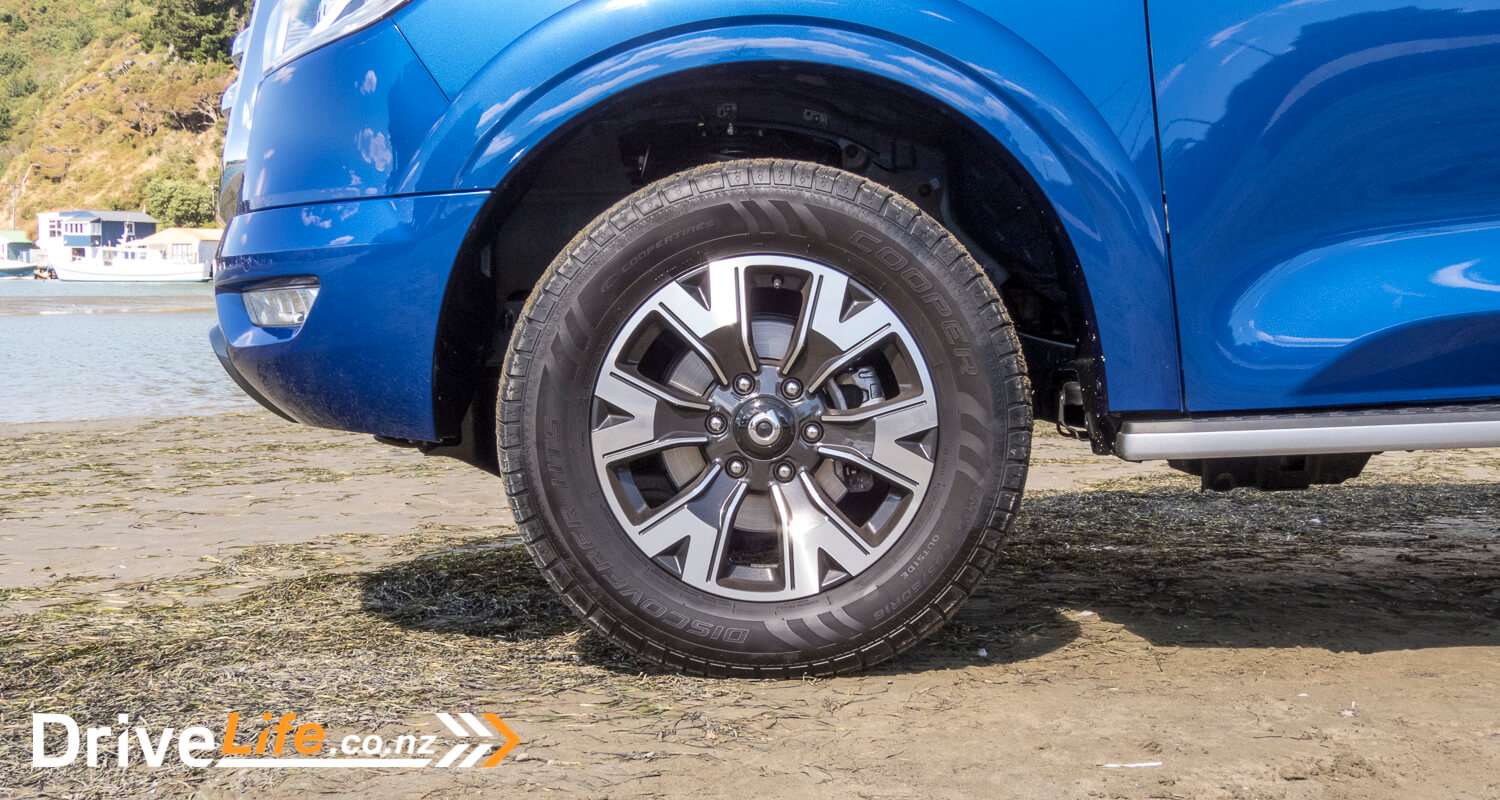
Ride quality was mostly par for the course in the ute class. The GWM has classic ute set-up; a ladder chassis, independent front suspension with leaf springs in the rear.
At suburban speeds, it exhibited traditional ute characteristics, meaning it had a slightly bouncy rear end. However, to GWMs credit, the ride actually became quite good the faster you went. During our test, the ute spent a decent amount of time on the motorway. It was compliant at high speed and was actually quite comfortable, which is a compliment I can’t extend to all ute’s I’ve tested.
Speaking of road time, our test of the GWM remained entirely on the tarmac. Our apologies to the off-road enthusiasts amongst us. I will say the spec sheet is promising, implying the GWM does have the gear for robust off-road capability.
As we’d mentioned earlier, the GWM has a full suite of driver assistance technology including adaptive cruise control. Having adaptive cruise at this price, this is impressive in the crossover class, and even more so for the ute class. The adaptive cruise also works down to a halt, which is another big tick. Not even a Hilux can do that.
The downside to the adaptive cruise system is that it does have a few rough edges, mainly in that it’s inputs can be slightly jerky. Also, when using the system in heavy traffic, you can hear audible clunks from the ABS when slowing itself to a halt. Either way, I’m just stoked to have the system.

On the slightly more annoying side was the lane keeping assistance system, which tended to supervise a little too often with its default settings. One annoying quirk of the GWM is that when the lane keeping assistance is active (and it is by default), it locks your digital display on the instrument cluster.
So, if you want to look at your trip meter or your digital speedo, you need to turn off lane-keeping assist.
Weird, but sure? I can do that for 30 seconds? Then you realise you need to navigate the central infotainment screen to a specific menu, and hit some very targeted touch controls to switch it off. It’s a bit of a silly decision, and reinforces the whole, ‘nearly but not quite’ aspects of this newcomer.
The final complaint, my hands couldn’t reach the paddle shifters from where they rested on the steering wheel. Go on, make whatever jokes you like.
What’s The Competition For The 2021 GWM Cannon L?
As mentioned in our intro, the price of your average ute has gone ballistic. Meaning this GWM seems like an absolute steal at $40,000.
For the below table, we’ve compared the higher-spec utes of the core competitors to compare alternatives relative to features as opposed to being the closest in price. You can get cheaper variants of the competition, but they’re considerably lower spec relative to the Cannon ute. Essentially, this is a spec vs spec table.
| Brand/Model | Engine | Power (kW)/Torque (Nm) | Economy, L/100km (claimed) | Tow Rating, Kg (Unbraked/Braked) | Price |
| Isuzu D-Max LS | 3.0-litre 4-cylinder turbodiesel | 140/450 | 7.7 | 750/3500 | $67,990 |
| Nissan Navara ST-X | 2.3-litre 4-cylinder twin-turbo diesel | 140/450 | 7.9 | 750/3500 | $67,490 |
| Ford Ranger XLT | 2-litre 4-cylinder twin turbodiesel | 157/500 | 8.4 | 750/3500 | $65,990 |
| Volkswagen Amarok Comfortline | 2-litre 4-cylinder twin-turbo diesel | 132/420 | 8.5 | 750/3200 | $63,000 |
| Toyota Hilux SR5 Cruiser | 2.8-litre 4-cylinder turbodiesel | 150/500 | 7.9 | 750/3500 | $61,290 |
| Mazda BT-50 Limited | 3.0-litre 4-cylinder turbodiesel | 140/450 | 8.0 | 750/3500 | $60,990 |
| Mitsubishi Triton VRX | 2.4-litre 4-cylinder turbodiesel | 135/437 | 8.6 | 750/3500 | $53,990 |
| GWM Cannon-L | 2-litre 4-cylinder turbodiesel | 120/400 | 9.4 | 750/3000 | $39,990 |
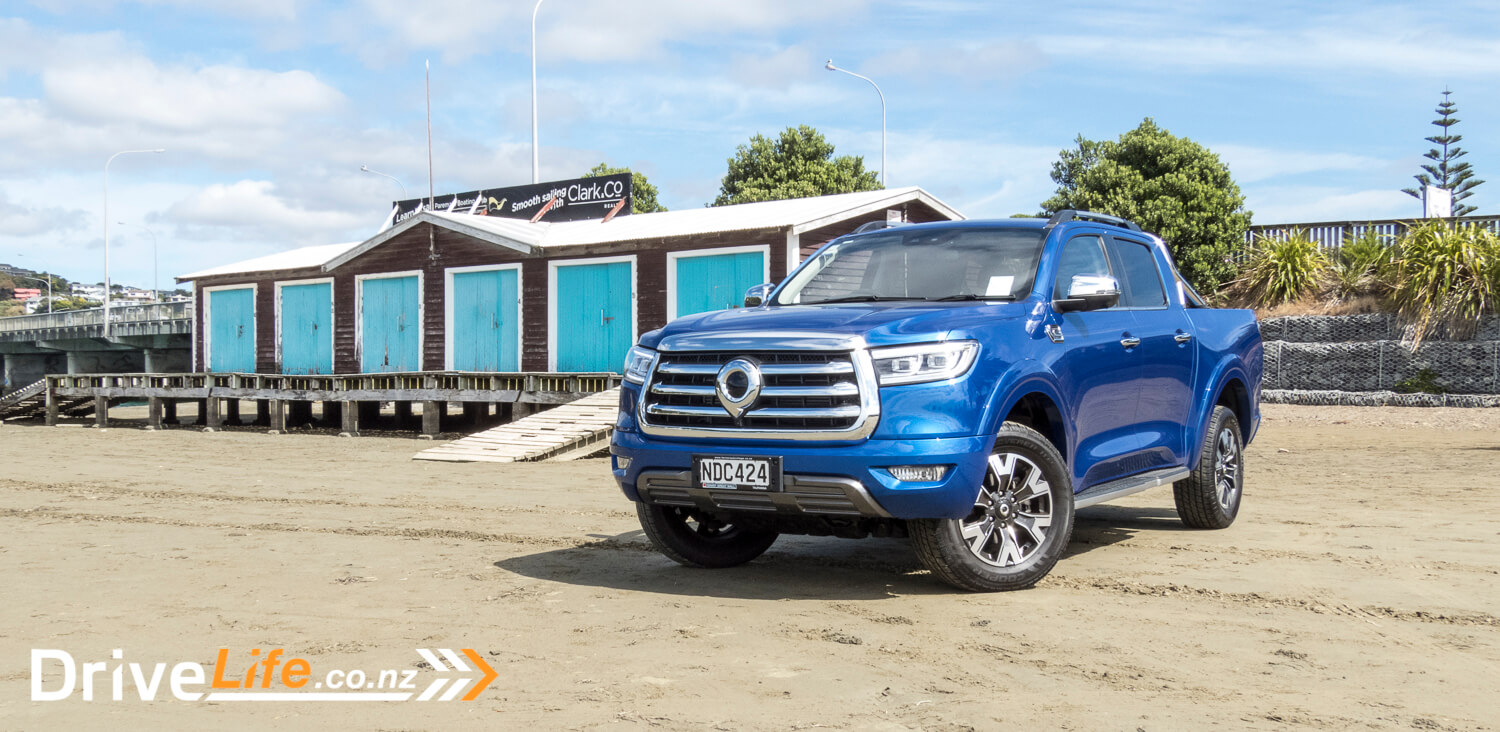
What’s The Pros And Cons Of The 2021 GWM Cannon L?
Pros
- Huge spec – leaves some utes for dead
- Excellent value
- Name-brand hardware
- Impressive camera system
- Decent ride quality
- Has all the Safety tech
- Plenty of thoughtful features (tail-gate step)
- Represents a massive step forward for GWM
Cons
- Gearbox requires some real-world calibration
- Engine a tad down on power
- Middle-of-the-road fuel economy
- Weird instrument cluster lockout for Lane Keep Assistance
- Tow rating only up to 3000kg
2021 GWM Cannon L – Specifications
| Vehicle Type | 5-door double-cab ute (4X4) |
| Starting Price | $39,990 |
| Price as Tested | $39,990 |
| Engine | 2-litre 4-cylinder turbodiesel |
| Power, Torque (kW/Nm) | 120/400 |
| Transmission | 8-speed automatic |
| Spare Wheel | Full size (steel) |
| Kerb Weight, Kg | 2,124 |
| Length x Width x Height (mm) | 5410 x 1934 x 1886 |
| Fuel tank Capacity, litres | 78 |
| Fuel Economy, L/100km (Combined) | Advertised Spec – 9.4 Real World Test – 9.6 |
| Towing Capacity Kg, unbraked/braked | 750/3000 |
| Tray Payload | 1,050kg |
| Approach/Departure Angle | 27/25 |
| Turning Circle | 13.1m Small: 6-10m / Medium 10-12m / Large 12m+ |
| Warranty | 5-year/150,000km new vehicle warranty 5-year Roadside Assistance |
| ANCAP Safety Ratings | Not tested |


